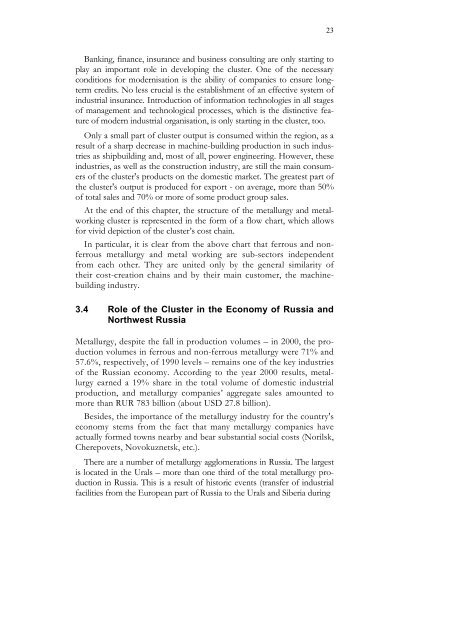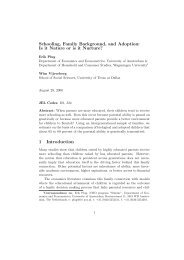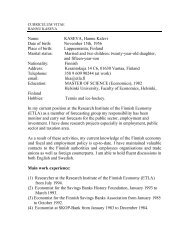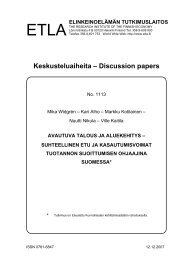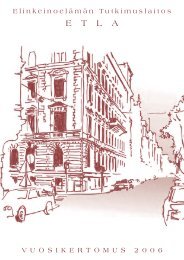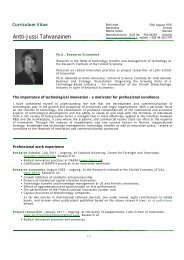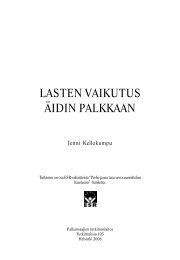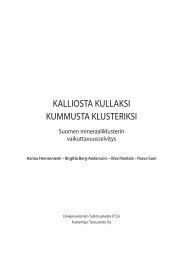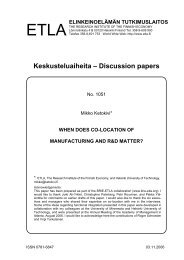Sergey Boltramovich, Grigory Dudarev, and Vladimir Gorelov ... - Etla
Sergey Boltramovich, Grigory Dudarev, and Vladimir Gorelov ... - Etla
Sergey Boltramovich, Grigory Dudarev, and Vladimir Gorelov ... - Etla
Create successful ePaper yourself
Turn your PDF publications into a flip-book with our unique Google optimized e-Paper software.
23<br />
Banking, finance, insurance <strong>and</strong> business consulting are only starting to<br />
play an important role in developing the cluster. One of the necessary<br />
conditions for modernisation is the ability of companies to ensure longterm<br />
credits. No less crucial is the establishment of an effective system of<br />
industrial insurance. Introduction of information technologies in all stages<br />
of management <strong>and</strong> technological processes, which is the distinctive feature<br />
of modern industrial organisation, is only starting in the cluster, too.<br />
Only a small part of cluster output is consumed within the region, as a<br />
result of a sharp decrease in machine-building production in such industries<br />
as shipbuilding <strong>and</strong>, most of all, power engineering. However, these<br />
industries, as well as the construction industry, are still the main consumers<br />
of the cluster's products on the domestic market. The greatest part of<br />
the cluster's output is produced for export - on average, more than 50%<br />
of total sales <strong>and</strong> 70% or more of some product group sales.<br />
At the end of this chapter, the structure of the metallurgy <strong>and</strong> metalworking<br />
cluster is represented in the form of a flow chart, which allows<br />
for vivid depiction of the cluster’s cost chain.<br />
In particular, it is clear from the above chart that ferrous <strong>and</strong> nonferrous<br />
metallurgy <strong>and</strong> metal working are sub-sectors independent<br />
from each other. They are united only by the general similarity of<br />
their cost-creation chains <strong>and</strong> by their main customer, the machinebuilding<br />
industry.<br />
3.4 Role of the Cluster in the Economy of Russia <strong>and</strong><br />
Northwest Russia<br />
Metallurgy, despite the fall in production volumes – in 2000, the production<br />
volumes in ferrous <strong>and</strong> non-ferrous metallurgy were 71% <strong>and</strong><br />
57.6%, respectively, of 1990 levels – remains one of the key industries<br />
of the Russian economy. According to the year 2000 results, metallurgy<br />
earned a 19% share in the total volume of domestic industrial<br />
production, <strong>and</strong> metallurgy companies’ aggregate sales amounted to<br />
more than RUR 783 billion (about USD 27.8 billion).<br />
Besides, the importance of the metallurgy industry for the country's<br />
economy stems from the fact that many metallurgy companies have<br />
actually formed towns nearby <strong>and</strong> bear substantial social costs (Norilsk,<br />
Cherepovets, Novokuznetsk, etc.).<br />
There are a number of metallurgy agglomerations in Russia. The largest<br />
is located in the Urals – more than one third of the total metallurgy production<br />
in Russia. This is a result of historic events (transfer of industrial<br />
facilities from the European part of Russia to the Urals <strong>and</strong> Siberia during


